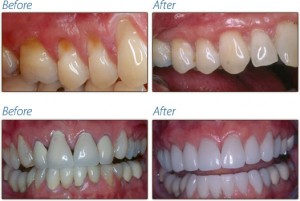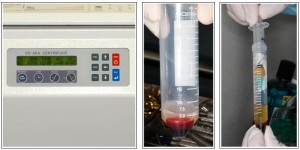Grafting has been used in Periodontal therapy and implants as a mean to reestablish the loss periodontal apparatus (alveolar bone, periodontal ligament, and cementum). Connective tissue graft also allowed to reestablish the gingival contour and architecture for the harmony and esthetic of the smile. In the past, these procedures can be enhanced by the use of membrane as the physical barrier to prevent epithelial and tissue migration in the graft site which may lead to contact inhibition of bone cell migration. Today, another breakthrough in the surgical procedure is the use of autologous platelet rich plasma (PRP) to improve surgical outcomes by accelerating the body’s natural healing process.
Platelet Rich Plasma (PRP) is exactly what its name suggests. The substance is a by-product of blood (plasma) that is rich in platelets. Until now, its use has been confined to the hospital setting. This was due mainly to the cost of separating the platelets from the blood (thousands) and the large amount of blood needed (one unit) to produce a suitable quantity of platelets. New technology permits the doctor to harvest and produce a sufficient quantity of platelets from only 55 cc of blood drawn from the patient while they are having outpatient surgery.
The use of autologous (self donated) biomaterials to naturally accelerate different types of healing processes historically was a relatively obscure practice. Platelets perform many functions, including formation of a blood clot and release of growth factors (GF) into the wound. These GF (platelet derived growth factors PGDF, transforming growth factor beta TGF, and insulin-like growth factor ILGF) function to assist the body in repairing itself by stimulating stem cells to regenerate new tissue. The more growth factors released sequestered into the wound, the more stem cells stimulated to produce new host tissue. Thus, one can easily see that PRP permits the body to heal faster and more efficiently.
The other functions of platelet rich plasma also includes enhancing hemostasis and clot stabilization, improving the handling characteristics of bone graft material and facilitating fixation of the bone graft material to the surgical site. A subfamily of TGF, is bone morphogenic protein (BMP). BMP has been shown to induce the formation of new bone in research studies in animals and humans. Due to all these great advantages, today it is becoming the standard-of-care.
James Rutkowski, DMD, PhD, reported at the recent annual scientific meeting of American Academy of Implant Dentistry that platelet – rich plasma therapy can accelerate bone and tissue growth and wound healing and assure long term success of dental implant placements.
“What could be better than using the body’s own regenerative powers to grow bone and soft tissue safely and quickly? For dental implant procedures, PRP treatments can jump start bone growth and implant adherence in just two weeks, which cuts down the time between implant placement and affixing the permanent crown.” said Rutkowski.
The plasma proteins are derived from the patient’s own blood within just a few short minutes with a specially designed centrifuge, therefore, disease transmission is not an issue. And since PRP harvesting is done with only 55 cc of blood in the doctor’s office, the patient need not incur the expense of the harvesting procedure in hospital or at the blood bank. Other common examples of self donated materials that are commonly used in dentistry today are bone and tissue specimens to augment a variety of oral and maxillofacial dental implant surgery procedures.
Accelerated Tissue Healing – Regeneration
Recent research has shown that certain properties of our own blood cells, namely: platelets, plasma, and white blood cells (aka Signal Proteins) have a profound effect for accelerating tissue regeneration that typically takes place with all forms of surgery.
The bioactive proteins carried by platelets are currently being used successfully in both hospitals and private practice office settings for wound healing in several surgical disciplines including orthopaedic, neurology, otolaryngology, cardiovascular, vascular, general, plastic and reconstructive, pediatrics and in oral surgeries.
Specifically, the plasma product can be routinely provided in a variety of oral surgeries that involve hard and soft tissues (maxillary, mandibular, gingival, etc) safely and securely with plasma derived from the patient (autologous).
The use of PRP augmented surgeries assures each and every patient maximum opportunity for treatment success. PRP is also invaluable for increasing implant and tissue surgery success for patients who have a history of problematic hard and/or soft tissue problems.
There are very few contraindications for any individual to receive PRP after undergoing dental implant surgery. Obviously, patients with bleeding disorders or hematologic diseases do not qualify for this in-office procedure. Check with your surgeon and/or primary care physician to determine if PRP is right for you. And this procedure is unfortunately not covered by most of the dental health insurance plan. The cost of the PRP application (approximately $400) is usually paid by the patient themself.

